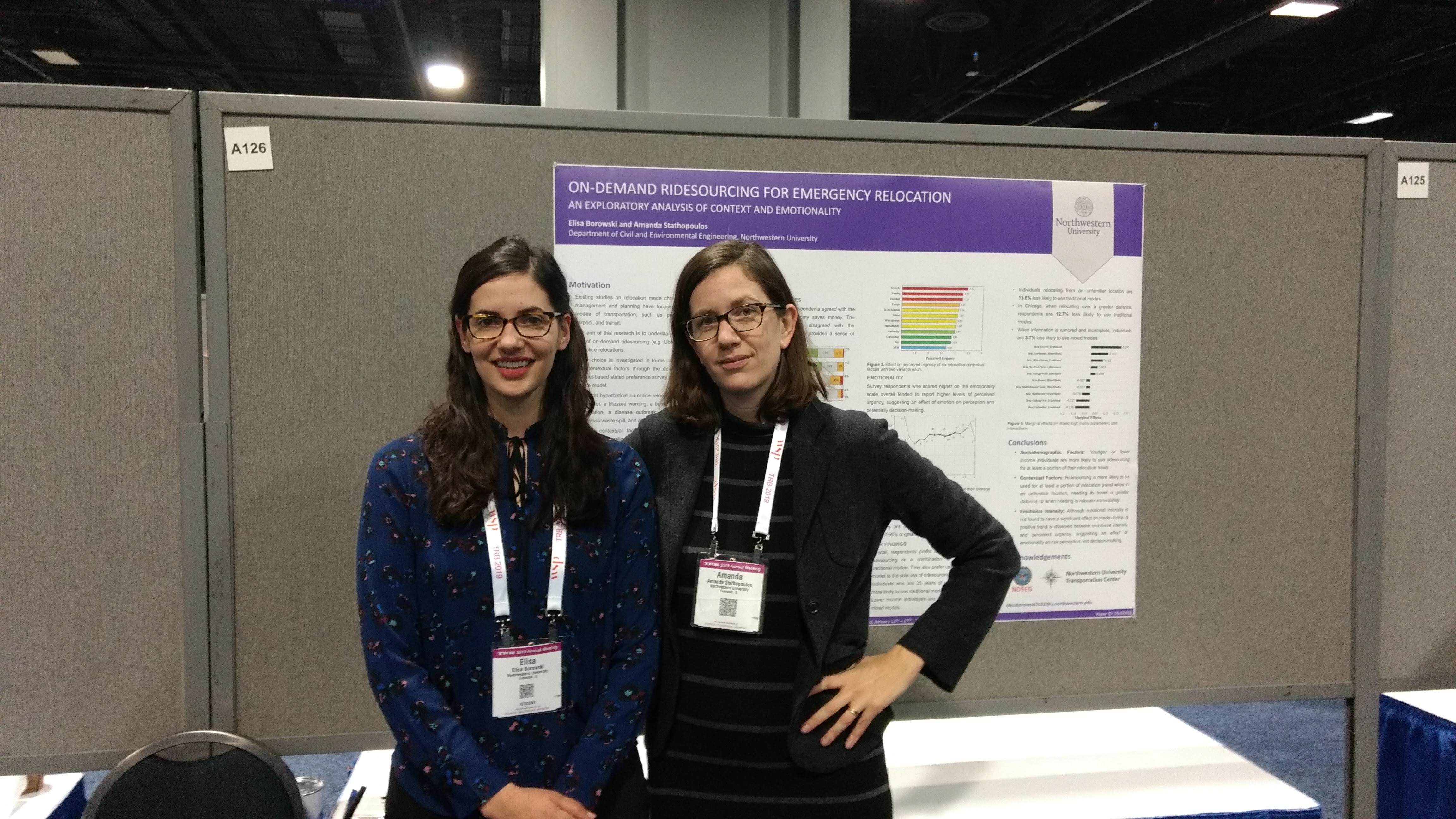Context Steers Emergency Ridesourcing Acceptance

A new study from Northwestern University investigates factors influencing the acceptance of emergency ridesourcing. Elisa Borowski, a CEE PhD student, and Professor Amanda Stathopoulos, an assistant professor in CEE, published the paper, On-demand ridesourcing for urban emergency evacuation events: An exploration of message content, emotionality, and intersectionality, in the International Journal of Disaster Risk Reduction. Borowski designed the stated preference choice experiment in a graduate level course on survey methods taught by Stathopoulos in Spring 2019. The research incorporates the effects of warning message content on risk perception, intersectional identity, and emotionality, drawing from an interdisciplinary research perspective spanning transportation engineering, sociology, and psychology.
 The study explores situational and sociodemographic interactions that affect the acceptance of ridesourcing (e.g., Uber, Lyft, Via, etc.) for emergency relocation by examining stated preferences of residents in Chicago, New York, and Los Angeles. The researchers identify specific uses of emergency ridesourcing that meet needs related to navigation, urgency, and vulnerability. Ridesourcing presents a new mode alternative for emergency relocation, but whether evacuees will access this additional capacity may depend on complex interactions between the specifics of the evacuation scenario and the sociodemographics of the affected communities.
The study explores situational and sociodemographic interactions that affect the acceptance of ridesourcing (e.g., Uber, Lyft, Via, etc.) for emergency relocation by examining stated preferences of residents in Chicago, New York, and Los Angeles. The researchers identify specific uses of emergency ridesourcing that meet needs related to navigation, urgency, and vulnerability. Ridesourcing presents a new mode alternative for emergency relocation, but whether evacuees will access this additional capacity may depend on complex interactions between the specifics of the evacuation scenario and the sociodemographics of the affected communities.
 The results show that ridesourcing has niche applications for urban evacuations. As anticipated, the researchers found that emergency ridesourcing is more likely to be used by evacuees under the age of 35 and for evacuations from unfamiliar areas. City-specific findings show an increased likelihood of using emergency ridesourcing during severe relocation scenarios in New York and for immediate evacuations in Chicago. Scenario-specific findings reveal an increased likelihood of using emergency ridesourcing for partial evacuation by lower income individuals when an authority figure has communicated the evacuation warning and by nonwhite individuals when evacuating with friends. Surprisingly, the researchers discovered that emergency ridesourcing is a preferred partial evacuation strategy by evacuees possessing intersectional identities, such as women of color and low-income black individuals, suggesting that those belonging to multiple minority groups who often experience multiplicative disadvantages could benefit from emergency ridesourcing initiatives.
The results show that ridesourcing has niche applications for urban evacuations. As anticipated, the researchers found that emergency ridesourcing is more likely to be used by evacuees under the age of 35 and for evacuations from unfamiliar areas. City-specific findings show an increased likelihood of using emergency ridesourcing during severe relocation scenarios in New York and for immediate evacuations in Chicago. Scenario-specific findings reveal an increased likelihood of using emergency ridesourcing for partial evacuation by lower income individuals when an authority figure has communicated the evacuation warning and by nonwhite individuals when evacuating with friends. Surprisingly, the researchers discovered that emergency ridesourcing is a preferred partial evacuation strategy by evacuees possessing intersectional identities, such as women of color and low-income black individuals, suggesting that those belonging to multiple minority groups who often experience multiplicative disadvantages could benefit from emergency ridesourcing initiatives.
These findings could help emergency managers anticipate the use of ridesourcing for relocation based on contextual factors of the evacuation scenario and the communities affected. The inclusion of ridesourcing in evacuation planning has the potential to enhance transportation resilience by providing dynamic on-demand adaptability. As our cities face more severe weather induced by climate change, evacuation frequency is increasing, and evacuation plans must consider the mobility needs of vulnerable populations. Given the rapidly changing environments housing our urban communities, it is crucial to consider the dynamics of social and environmental contexts. The contemporary movement of local disaster response facilitated by crowdsourcing and the sharing economy requires us to recognize that emergency ridesourcing does not offer a one-size-fits-all solution. The study on context-based acceptance highlights the need for community-tailored emergency response strategies.

Crowdsourcing technology is growing in its ubiquity, but ridesourcing as we know it presents significant challenges involving distrust and unreliability. However, the future of crowdsourcing for disaster response need not fit the mold of current transportation network companies. Grassroots efforts like the Crowdsource Rescue platform developed in Houston, TX use the same mapping and global positioning system tracking technology to rescue and evacuate disaster victims. By better understanding both the usefulness and challenges surrounding crowdsourcing for disaster response, we can better design flexible systems that leverage the resource capacity of the crowd to assistant in the evacuation of vulnerable individuals. This understanding, however, is only a first step. The next crucial step involves engagement of communities in the design of crowdsourced disaster response strategies.
